Highgate
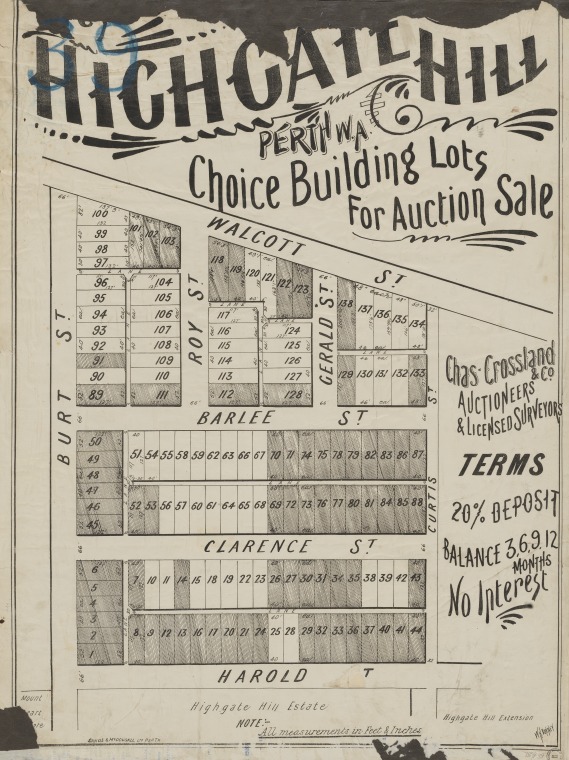
Highgate Hill, 1900 (SLWA 55/17/39)
The area known today as Highgate is bounded by Lincoln, Lord, Harold and William Streets. It was called "Highgate Hill" by surveyor Charles Crossland in 1874 and was named for his birthplace of Highgate, the village (now suburb) north of London.
Early History
Highgate lies in a chain of seasonal wetlands of practical and spiritual importance to the Whadjuk Noongar people. Wetlands in the area, including were places to camp and hunt or gather food, and their creation was associated with the Waugal rainbow serpent. There are two registered Aboriginal heritage sites in proximity to the Highgate area, Yoordogoorading (Stone’s Lake, now Perth Oval/HBF Park) (Place 3753) and Boodjamooling (Hyde Park) (Place 3792).
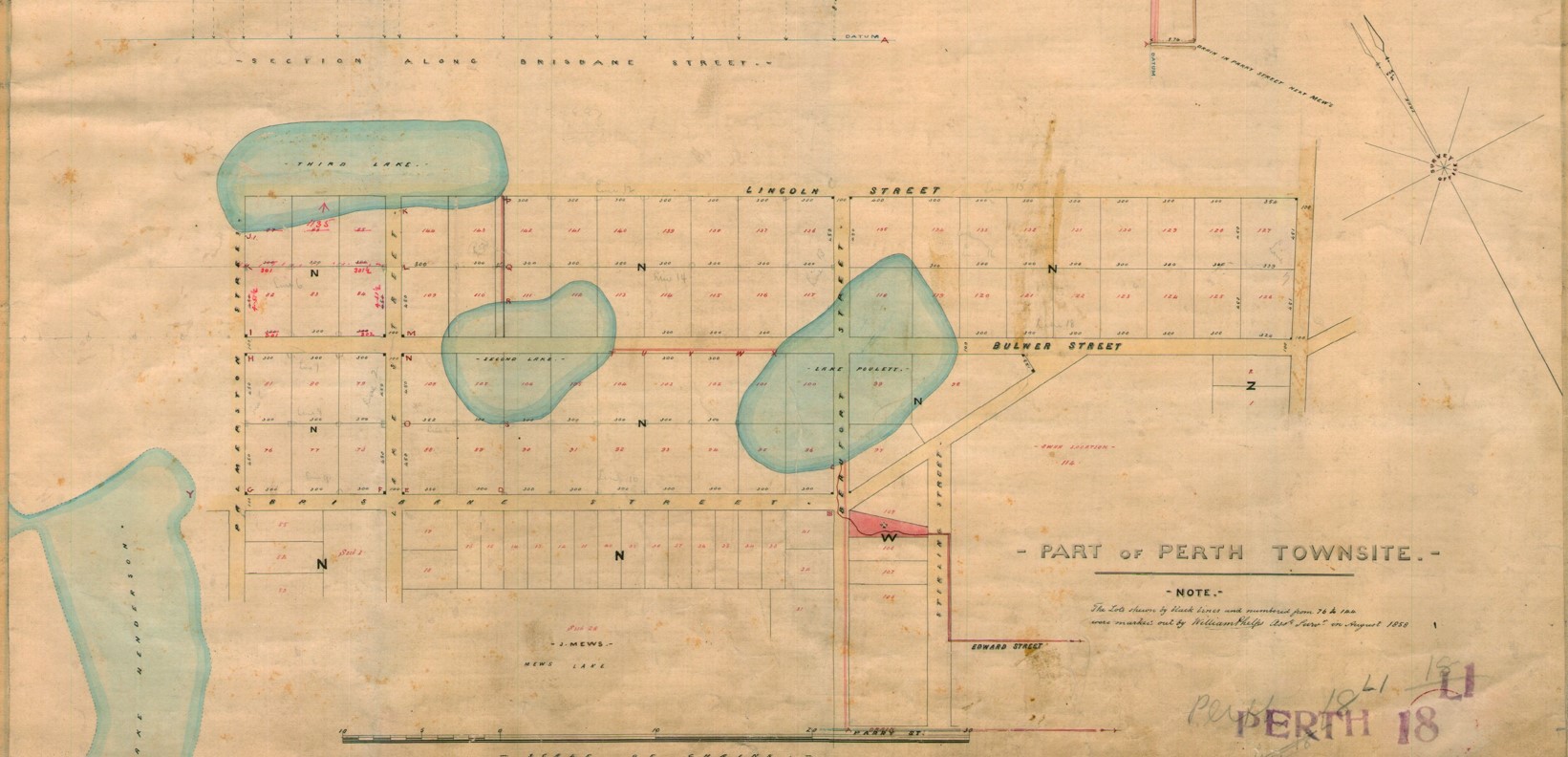
Part of Perth Townsite showing swamps in Highgate area, 1858 (State Records office Cons 3868 Item 302)
After colonisation, many of the Perth’s seasonal swamps were drained or filled in and Noongar people were discouraged from camping, hunting, and fishing in the wetland areas which remained. Nonetheless, there are reports in the 1800s and early 1900s of Noongar people continuing to use the area.
Reflecting on his boyhood in Perth in the 1850s-1860s, early colonist James Kennedy recalled: “The natives swarmed in Perth in those days. Most of them camped at the Third Swamp (now Hyde Park) and other camping places…I have seen 300 camped at the Third Swamp at one time waiting for a corroboree. There were tremendous paper bark trees there and the natives used to tear down slabs of bark to make their huts.” (James Kennedy, Early Days Vol, 1 1927).
In the 1850s, the area around Stone's Lake was filled in and subdivided and sold as market gardens, homes, and small farms. Land in the area was granted to the Church of England in the 1870s. It remained unused until 1889, when open air services commenced under a large gum tree on the site of the present-day St Alban’s Church on Beaufort and Lincoln Streets.
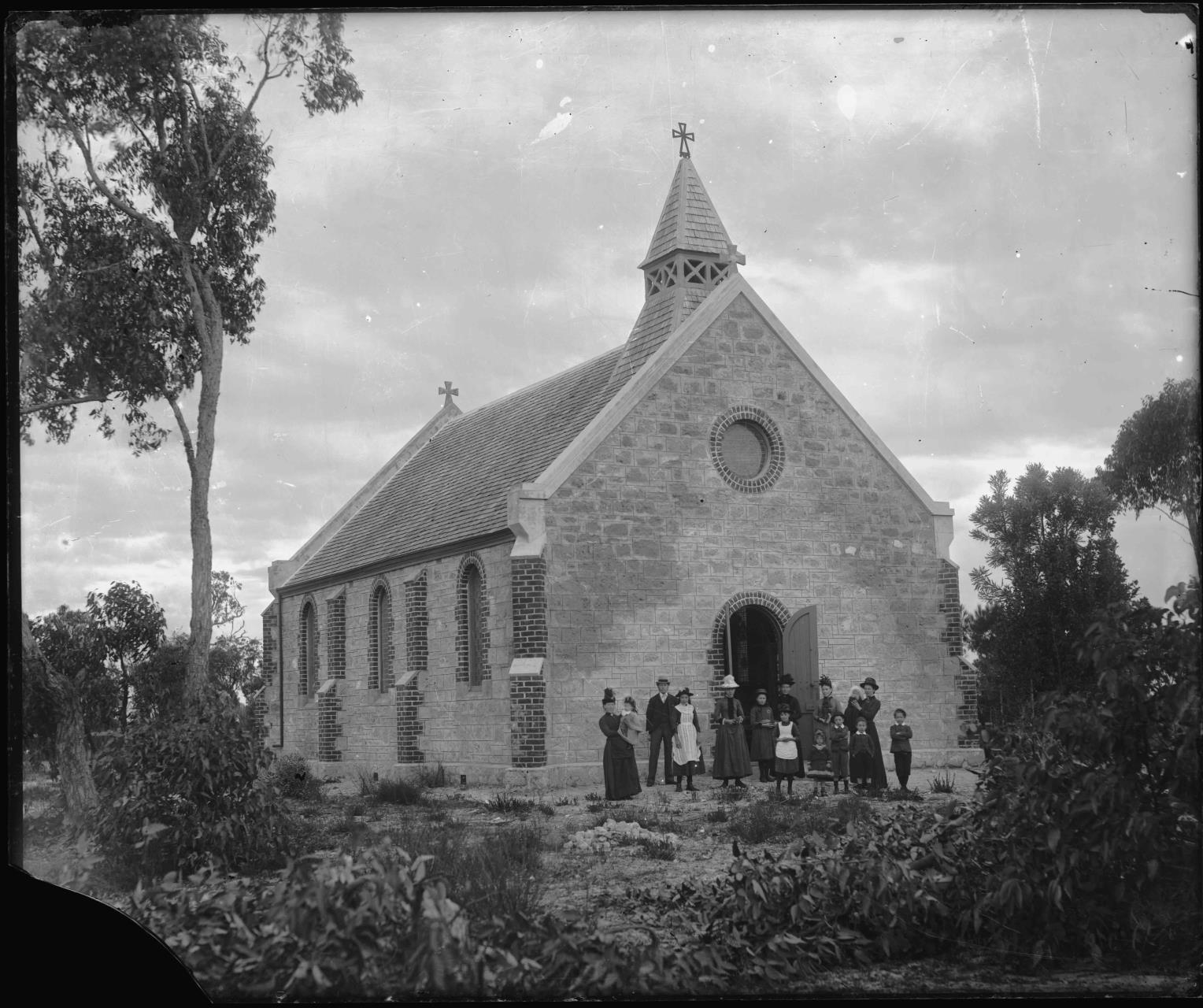
St Alban’s Anglican Church, Highgate c.1890 (SLWA slwa_b2459543_1)
In 1891, Beaufort Street was paved only a short way past St Alban’s Church. Beyond was open bushland and very little residential or commercial development. The area was distinguished by a tall tree with steps and a lookout known as the ‘Crow’s Nest’ located on what became Mary Street. According to the newspapers of the day, the crow’s nest tree was a city landmark and a popular spot for Perth residents to picnic, drink and sometimes fight. When the tree was cut down in 1903, a contributor to the WA Record was moved to write an ode to the ‘Crow’s Nest Tree'.
The gold rush of the 1890s saw dramatic expansion of Perth and growth of new suburbs. To accommodate the demand for housing, rural allotments close to Perth were subdivided and progressively released for sale.
The earliest subdivision in the Highgate area was the Mount Heart Estate (also known as the ‘Crow’s Nest Estate’), developed in 1892. The land was owned by prominent Perth businessman James Grave, then acquired by the then Mayor of Perth, Alexander Forrest, who sold off a portion to Mathew Gibney (Catholic Bishop of Perth from 1887-1910).
Mount Heart Estate was advertised as being ideally located close to the city and transport routes with lots offered for sale at a cost of 65 pounds (Freeman’s Journal, 16 Jan 1892). The centre of the estate was reserved as ‘Alacoque Square,’ named for Saint Margaret Mary Alocoque, the French nun who promoted devotion to the Sacred Heart of Jesus. The area became the heart of a Catholic precinct, which included the Sacred Heart Church & Convent, with adjoining school and housing for clergy and lay workers.
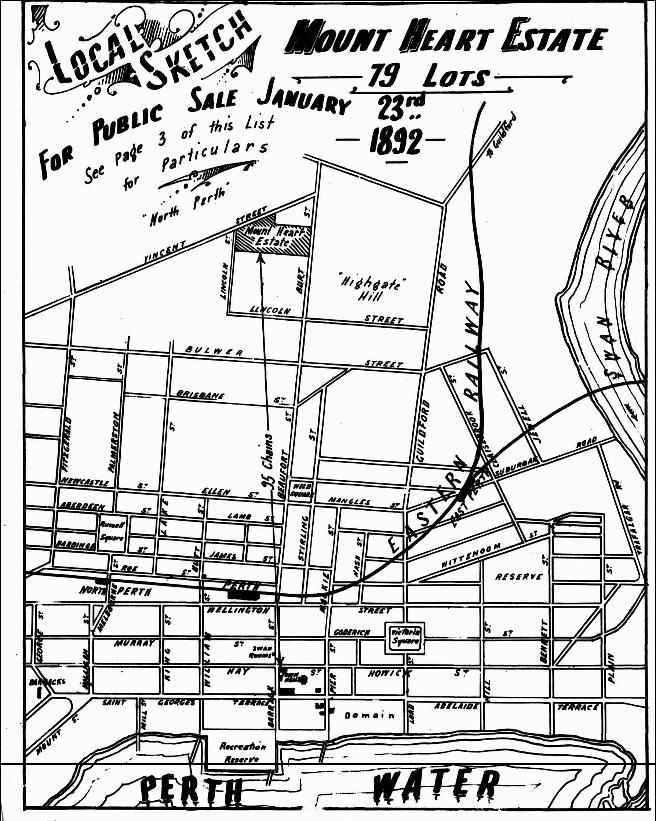
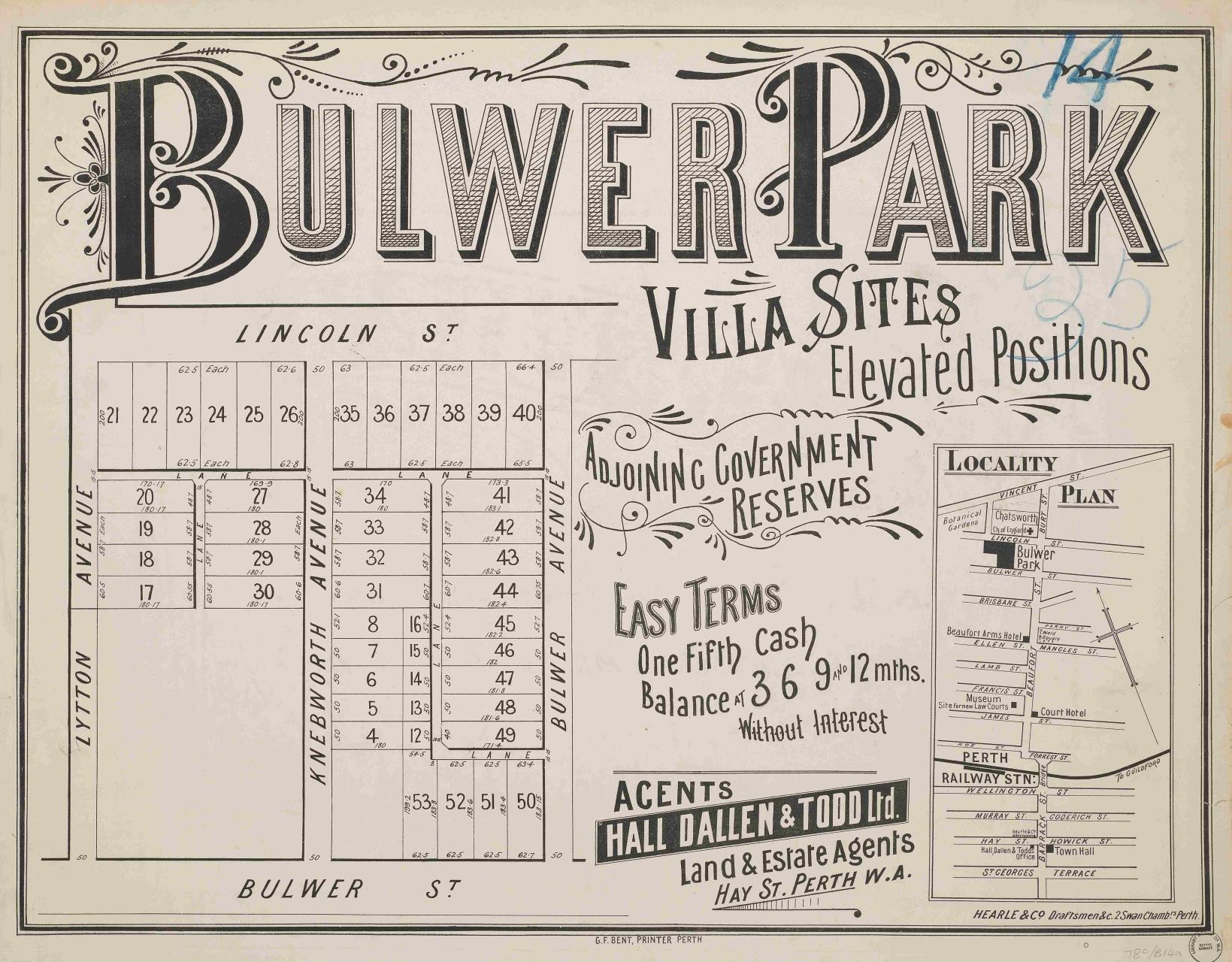
Mount Heart Estate Advertisement (WA Record, 24 December 1891, p 4) Bulwer Park, 1895 (SLWA 55/14/14a)
Early Highgate subdivisions included:
- Mount Heart Estate, 1891 – east of Lincoln Street south of Vincent
- Bulwer Park, 1895 - bounded by Lytton Avenue (William Street), Lincoln Street, Bulwer Avenue, Bulwer Street.
- Lord Street Estate, c.1895 - bounded by Lord Street, Summers Street, Claisebrook, Murchison Terrace.
- Woodley Park, 1897 - bounded by Wright Street, Harold Street, Guildford Road (Lord Street), Broome Street.
- Highgate Hill, Perth c.1900 - bounded by Burt Street (Beaufort Street), Walcott Street, Curtis Street, Harold Street.
- Highgate Hill Extension, 1900 - bounded by Wright Street, Harold Street, Guildford Road (Lord Street), Broome Street.
The 1890s also saw the development of public amenities and services in the area. In 1895, Highgate School opened at 147 Lincoln Street, originally as a two-room school. In 1900 it was expanded to include an Infants School for 6 to 7 year olds.

Highgate State School, 1895 (COV PHO1110)
The Highgate Police Station at 57 Lincoln Street was established in 1897. This was the first police station and lockup built to the immediate north of Perth.
The Queens Hotel was built in 1897, originally as a private residence for boot manufacturer John Andew Gent. From 1898, it was leased as the Queens Hotel.

Queens Hotel, c.1910 (COV PHO2954)
In 1897, an Orthodox Jewish synagogue was erected in Brisbane Street. The large synagogue and its related social institutions including a Hebrew School, attracted many Jewish residents to the area, enabling them to observe orthodox tradition by living within walking distance to the Synagogue.

Brisbane Street Synagogue, c.1906 (COV PHO6126)
In 1897, the Reserve previously known as ‘Third Swamp’ which had been leased out as a ‘tent city’ to gold rush newcomers by Perth City Council was gazetted as a public park.
In 1900, the Perth Electric Tramway extended its route along Beaufort Street further hastening development of the area. The introduction of the tram service stimulated commercial growth along Beaufort Street.
By 1905, the section of Beaufort Street between Chatsworth and Mary Streets had developed into a retail area with businesses including a chemist, baker, bookseller, draper, confectioner, ironmonger, stationer, butcher, fruiter, wood yard, bootmaker and ‘fancy repository’ (an old fashioned version of a dollar store).
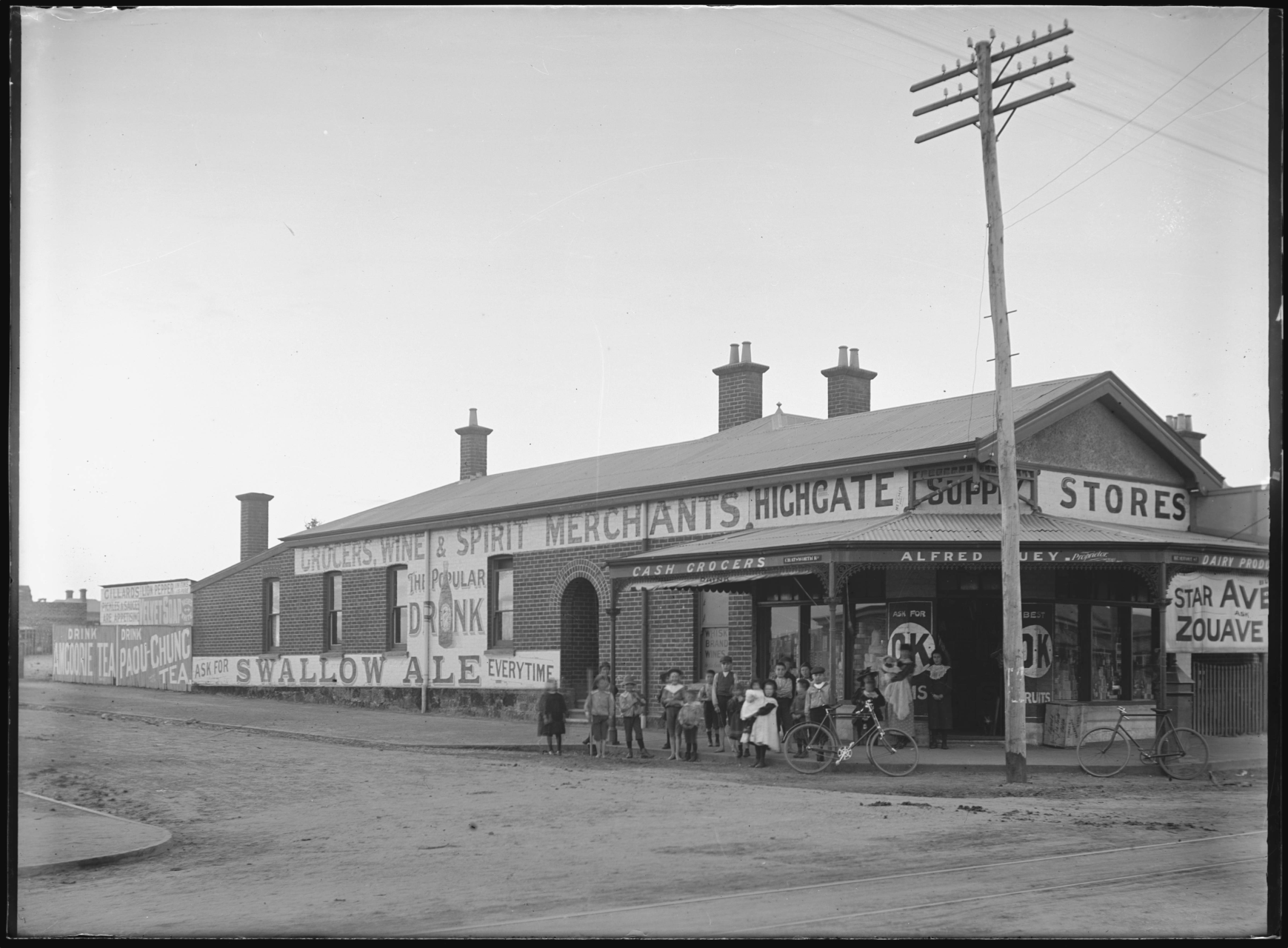
Alfred Huey, Grocer at 411 Beaufort Street ,Highgate, c.1905-1910 (SLWA 006631PD)
1900s - 1950s
In the early 1900s, Highgate was being promoted as a rapidly growing and bustling suburb with a mix of residential, commercial and light industrial buildings.
Thomas Plunkett established a joinery business in Smith Street in the early 1903, which later grew into a building company instrumental in the residential development of suburbs around Perth (Plunkett Home, inHerit Place 17616).

Plunkett’s Joinery Workshop, Smith Street Highgate (SLWA 240308PD)
Around WWI, residents in the area enjoyed a thriving social scene with numerous community and sporting groups associated with the nearby Anglican, Catholic and Jewish places of worship.
Early Highgate was also home to two women’s welfare centres; Cornelie Home (also known as the ‘Perth Rescue Home’) for single mothers and destitute women run by the Salvation Army from 1898-1903 on Lincoln Street; and the House of Mercy (later known as the Alexandra Home for Women then Ngala), another home “for the shelter and reformation of women and girls who have fallen from virtue” (Daily News, 13 June 1891) which also operated on Lincoln Street from 1901-1950.
During WWI, men from Highgate were among the 32,000 Western Australians sent to battle. A Mount Lawley/North Perth branch of the Returned Servicemen’s League was established to memorialise the war and provide support for returned veterans in the area. A specific Highgate RSL branch was established after WWII.
In 1925, the Premier Theatre was built on the corner of Stirling and Bulwer Streets, funded by and closely connected to the East Perth Football Club whose headquarters were at nearby Perth Oval. The adjacent outdoor picture gardens were opened in 1937.


Premier Theatre & Gardens, 1956 (COV PHO2611) Premier outdoor Summer Gardens, 1956 (COVPHO2620)
During the inter-war period, the Great Depression impacted residents with unemployment skyrocketing and many unemployed men forced to leave the City to undertake sustenance work in country areas. In the early 1930s, Highgate Infants School was allocated labour gangs to repair buildings through the government funded sustenance scheme to help the unemployed (Kalgoorlie Miner, 13 July 1933).
Highgate School was one of the largest public schools in Perth in the 1930s, with a student population made of a range of European migrants described in the local papers as “a veritable League of Nations” (The West Australian, 7 July 1938). This multicultural heritage was to continue into the post-war period, with Highgate Primary a pioneer in the delivery of specialist programs for newly arrived migrant and refugee children.

Students in Highgate Primary School Hall, 1948 (COV PHO1120)
On the home front during WWII, the Highgate area hosted several civil defence facilities including a secret aerial communications tower in the Lincoln Street Ventilation Stack. The art deco style tower, built in 1941 to vent sewerage fumes, did not function properly and was quickly sealed over. During the war, the police wireless facility was secretly moved to the Highgate Hill Police Station and the nearby tower was used to hide a communications antenna. The tower, a Highgate landmark, was used for an antenna mast for police wireless communications until 1975.
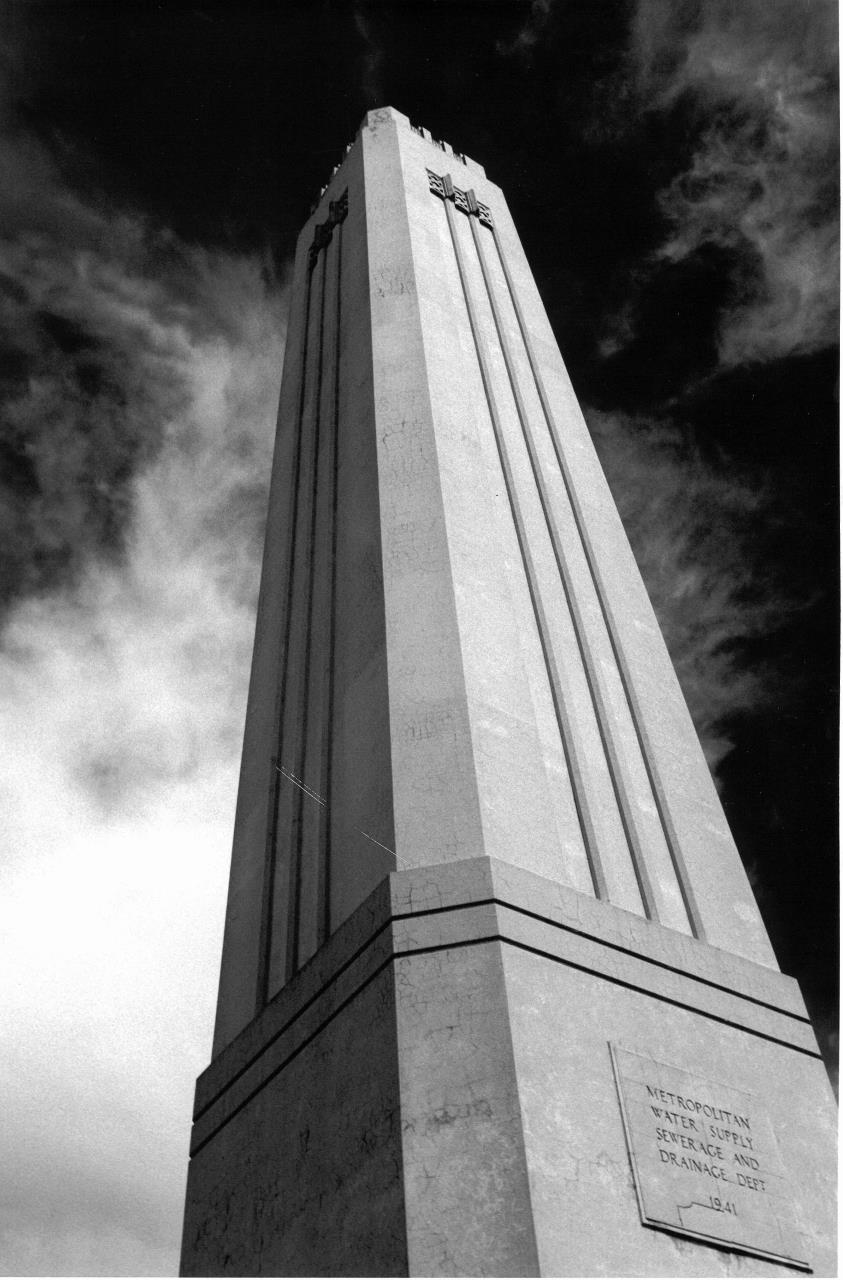
Lincoln Street Ventilation Stack, c.2000 (COV PHO5725)
1950s - 1990s
The post-war population boom, coupled with the renewed immigration drive, saw the population of Perth increase dramatically. Migrants and displaced persons joined their family and compatriots in inner city areas like Highgate that were close to the many industrial workshops and factories in the area. Proximity to kin and to social and cultural institutions such as the Jewish Orthodox Synagogue in Bulwer Street also made Highgate a popular residential suburb for new migrants and refugees.
In a time of housing and building supply shortages, many existing dwellings were divided into flats, with multiple families often living together in makeshift extensions or enclosed verandas. In the early 1950s, a 2-bedroom brick home in Highgate sold for around £3,000 to £4,000 (and rented at around £5-10 per week), at a time when the average weekly income for males in the early 1950 was around £12, with the minimum wage at £8 per week.
Beaufort Street continued to be a busy commercial strip with every lot north from Chatsworth and Lincoln Streets to Walcott Street occupied by some type of business. Apart from the ubiquitous corner grocery stores, there were furniture and hardware dealers, engineering works, wood yards, fuel merchants, garages, a wine saloon, radio and music shops and photographers. Nestled in among the corner shops and retail businesses were cottage industries such as Turvey Brothers furniture makers, which operated at 521-525 Beaufort Street from 1925 until the late 1960s.
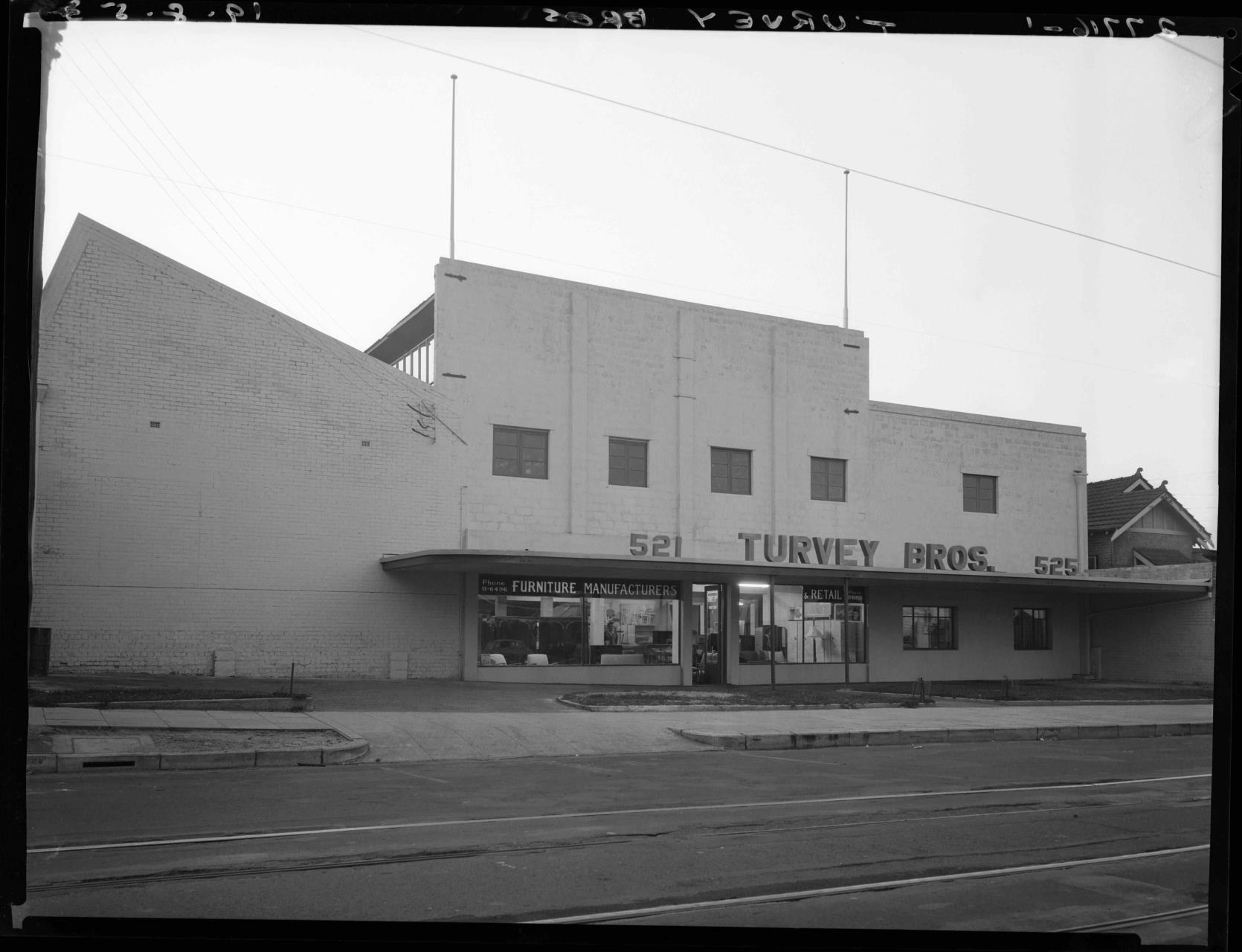
Turvey Bros 521-525 Beaufort Street , 1953 (SLWA_b2316351)
The growth of car culture in the 1950s and '60s affected some of the smaller retail businesses on Beaufort Street, which struggled to compete with new shopping centres in the suburbs. Television also impacted on businesses such as theatres with the closure of the Premier Theatre on Stirling and Bulwer Streets in 1963. The theatre was converted into an ice-skating rink and later disco, before it was demolished in 1987.
In the early 1970s, the State Government built the twelve-storey Stirling Towers in Smith Street, Highgate to provide public housing in the area. A further three-storey block of 12 units was built adjacent to the original tower in 1999. Stirling Towers housed Homeswest tenants until 2015 when, after many years of drug and vandalism issues, the Department of Housing relocated the last tenants and evicted the squatters. Discussions for the future of the site for public housing are ongoing.
Throughout the 1990s, there were increasing issues relating to street prostitution in the area east of Beaufort Street. Public concerns increased and was at odds with increasing urban gentrification and redevelopment of the Beaufort Street commercial strip. The refurbishment of the Queens Hotel in 1986 and renovation of the Astor Theatre in 1989 reinvigorated Beaufort Street as a café and restaurant precinct.

Architect Michael Patroni in the renovated Queens Hotel, 1986 (COV PHO2951)
2000s -
Beaufort Street has remained a prominent commercial street, enlivened by events such as the Beaufort Street Festival, which took place each November from 2010-2015. Organised by the Beaufort Street Network, one of the first ‘town teams’ in Perth, the Festival attracted 150,000 people in its final year. It was discontinued in 2016, as it had become too large and expensive to run (WA Today, 2 March 2016).
Since the 2000s, there has been an increase in construction of medium and high density housing in Highgate. This has resulted in a demographic shift to younger, lone person households (Profile ID Highgate, 2022). In 2021, Highgate was home to 2,326 people (539 families) living in over 1,400 private dwelllings, a much higher proportion of which are flats and apartments (53%) compared with the Western Australian average (6%) (ABS 2021).
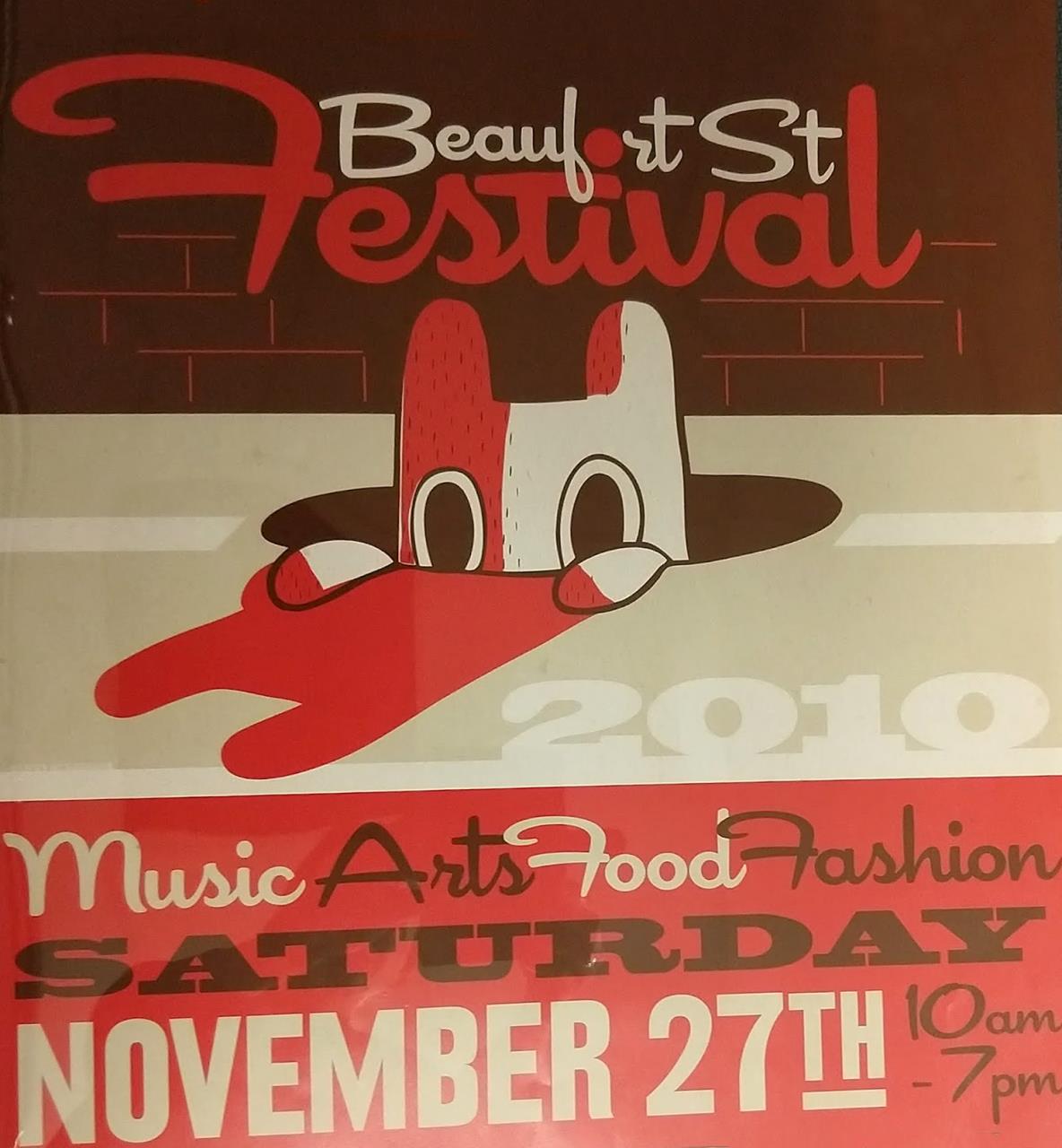
For more great photos of Highgate visit the Local History Image Gallery: Highgate History Album
If you have any further information about or photographs of Highgate, please contact us at local.history@vincent.wa.gov.au